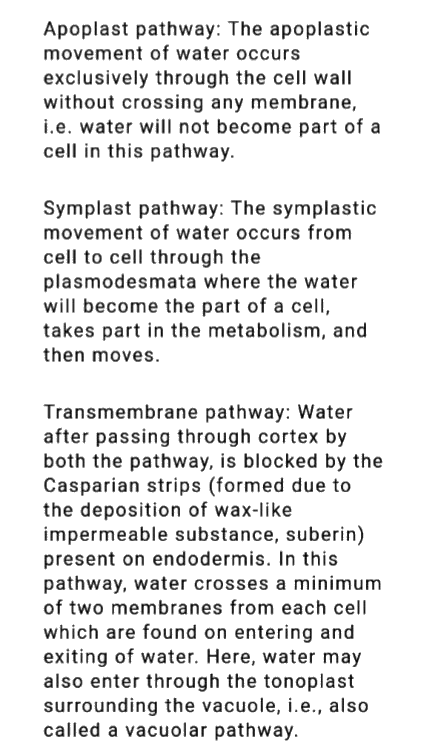A botanist discovered a mutant plant that was unable to produce materials that form Casparian strip. This plant would be
A
Unable to transport water or solutes to the leaves.
B
Unable to use its sugar as a sugar sink.
C
Able to exert greater root pressure than the normal plant.
D
Unable to control amounts of water and-solutes it absorbs.
Text Solution
The correct Answer is:D
Water in the root moves through three pathways, such as the apoplast pathway, symplast pathway, and transmembrane pathways. Munch coined the term apoplast and symplast.

The Casparian strip is a band of waterproof, corky tissue that is formed by the deposition of lignin and suberin, found on the side and walls of the endodermis of the roots. This strip is impermeable due to the depositions and prevents water from entering the pericycle only except through the cytoplasm of endodermal cells (passage cells). This is important in producing root pressure, which, in turn, regulates the flow of water between outer tissues and the vascular cylinder at the centre of the root.
Now, if a plant gets mutated and due to that was unable to produce the Casparian strips, the plant will fail to control the amount of water and solutes it absorbs.
Apoplast pathway: The apoplastic movement of water occurs exclusively through the cell wall without crossing any membrane, i.e. water will not become part of a cell in this pathway.
Symplast pathway: The symplastic movement of water occurs from cell to cell through the plasmodesmata where the water will become the part of a cell, takes part in the metabolism, and then moves.
Transmembrane pathway: Water after passing through cortex by both the pathway, is blocked by the Casparian strips (formed due to the deposition of wax-like impermeable substance, suberin) present on endodermis. In this pathway, water crosses a minimum of two membranes from each cell which are found on entering and exiting of water. Here, water may also enter through the tonoplast surrounding the vacuole, i.e., also called a vacuolar pathway.
The Casparian strip is a band of waterproof, corky tissue that is formed by the deposition of lignin and suberin, found on the side and walls of the endodermis of the roots . This strip is impermeable due to the depositions and prevents water from entering the pericycle only expect through the cytoplasm of endodermal cells (passage cells). This is important in prodcuing root pressure, which in turn , regulates the flow of water between outer tissues and the vascular cylinder at the centre of the root.
Now, if a plants gets mutated and due to that was unable to produce the Casparian strips, the plants will fail to control the amount of water and solutes it absorbs.
|
Updated on:21/07/2023
Topper's Solved these Questions
Similar Questions
Knowledge Check
- Question 1 - Select One
A mutant plant is unable to produce materials or precursors that form Casparians trip. This plant would be
AUnable to transport water or solutes to the leavesBUnable to use its sugar as a sugar sinkCAble to exert greater root pressure than the normal plantDUnable to control amounts of water and solutes it absorbs - Question 2 - Select One
A mutant plant is unable to produce materials or precursors that form Casparians trip. This plant would be
Aunable to transport water from roots to the leavesBable to exert greater root pressure than the normal plantCunable to transport food from leaves to rootsDunable to control amount of water and solute it absorbs - Question 3 - Select One
Most plant virus have genetic material in the form of
ADNABRNACRNADRNA+DNA
Plants which are unable to manufacture their food wholly or partially are
View SolutionWater impermeable, waxy material suberin in the form of strips is present in the
View SolutionIn plants, the hapolid plant body produces :
View SolutionThe waxy material deposited in the casparian strip of the endodermis is
View SolutionAlbinism in corn Zea mays is due to lethal gene.
The mutant plant is unable to produce sufficient melanin.View Solution

